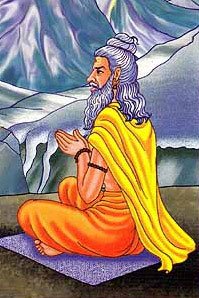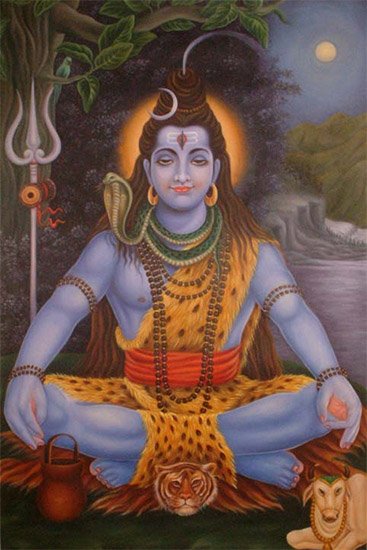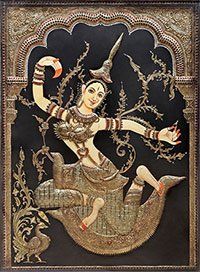Ahvana, Āhvāna: 14 definitions
Introduction:
Ahvana means something in Hinduism, Sanskrit, Hindi. If you want to know the exact meaning, history, etymology or English translation of this term then check out the descriptions on this page. Add your comment or reference to a book if you want to contribute to this summary article.
Alternative spellings of this word include Ahvan.
Images (photo gallery)
In Hinduism
Purana and Itihasa (epic history)
Source: archive.org: Shiva Purana - English TranslationĀhvāna (आह्वान, “invocation”) is the name of a certain rite mentioned in the Śivapurāṇa 1.20 while explaining the mode of worshipping an earthen phallic image (pārthiva-liṅga) according to the Vedic rites:—“[...] the phallic image shall be prepared with the Aghora-mantra. The Āhvāna (invocation) shall be performed with the mantra ‘Tatpuruṣāya’”.

The Purana (पुराण, purāṇas) refers to Sanskrit literature preserving ancient India’s vast cultural history, including historical legends, religious ceremonies, various arts and sciences. The eighteen mahapuranas total over 400,000 shlokas (metrical couplets) and date to at least several centuries BCE.
Shaivism (Shaiva philosophy)
Source: SOAS University of London: Protective Rites in the Netra TantraĀhvāna (आह्वान) refers to the “(offerings of) inviting”, according to the Netratantroddyota commentary on the Netratantra of Kṣemarāja: a Śaiva text from the 9th century in which Śiva (Bhairava) teaches Pārvatī topics such as metaphysics, cosmology, and soteriology.—Accordingly, [verse 8.4.7, while describing the purification process of the initiand]—“Next, after [the Mantrin has] caused the cessation, etc. [of differentiation], as taught of the eight-fold subtle body through the offerings of inviting (āhvāna), reverence and oblation, [and] after he has purified all the paths, after he has first united [the initiand] with all the other tattvas, beginning with kalā, he should then] cut off of the topknot and perform homa. [...]”.

Shaiva (शैव, śaiva) or Shaivism (śaivism) represents a tradition of Hinduism worshiping Shiva as the supreme being. Closely related to Shaktism, Shaiva literature includes a range of scriptures, including Tantras, while the root of this tradition may be traced back to the ancient Vedas.
Sports, Arts and Entertainment (wordly enjoyments)
Source: archive.org: Syainika Sastra of Rudradeva with English Translation (art)Āhvāna (आह्वान) refers to “calling (the hawk)” (as part of its training), according to the Śyainika-śāstra: a Sanskrit treatise dealing with the divisions and benefits of Hunting and Hawking, written by Rājā Rudradeva (or Candradeva) in possibly the 13th century.—Accordingly, [while discussing the training of hawks]: “In calling (āhvāna) the hawk, either its wings should be tied or it should be covered with cloth. When it comes it should be rewarded by food, so that it may not be disappointed. [...] If highly fed, they grow naughty ; if starved, they do not grow attached or strong. Birds of this clas are like low people. [...]”.

This section covers the skills and profiencies of the Kalas (“performing arts”) and Shastras (“sciences”) involving ancient Indian traditions of sports, games, arts, entertainment, love-making and other means of wordly enjoyments. Traditionally these topics were dealt with in Sanskrit treatises explaing the philosophy and the justification of enjoying the pleasures of the senses.
Languages of India and abroad
Sanskrit dictionary
Source: DDSA: The practical Sanskrit-English dictionaryĀhvāna (आह्वान).—
1) Calling, inviting.
2) A call, invitation, summons (in general); सुहृदाह्वानं प्रकुर्वीत (suhṛdāhvānaṃ prakurvīta) Pañcatantra (Bombay) 3.47.
3) A legal summons (from court or govt. to appear before a tribunal); Mṛcchakaṭika 9.
4) Invocation of a deity; जन्म- ज्येष्ठेन चाह्वानं सुब्रह्मण्यास्वपि स्मृतम् (janma- jyeṣṭhena cāhvānaṃ subrahmaṇyāsvapi smṛtam) Manusmṛti 9.126.
5) A challenge.
6) A name, appellation.
7) Name of a liturgical formula.
Derivable forms: āhvānam (आह्वानम्).
Source: Cologne Digital Sanskrit Dictionaries: Shabda-Sagara Sanskrit-English DictionaryĀhvāna (आह्वान).—n.
(-naṃ) 1. Calling, a call or summons. 2. Legal summons. 3. A name, an appellation. 4. Invocation, invitation. E. āṅ before hveñ to call, lyuṭ aff.
Source: Cologne Digital Sanskrit Dictionaries: Benfey Sanskrit-English DictionaryĀhvāna (आह्वान).—i. e. ā-hve + ana, n. 1. Calling, summons, [Pañcatantra] iii. [distich] 44. 2. An invocation, [Mānavadharmaśāstra] 9, 126. 3. A challenge, [Rāmāyaṇa] 4, 13, 40.
Source: Cologne Digital Sanskrit Dictionaries: Cappeller Sanskrit-English DictionaryĀhvāna (आह्वान).—[neuter] calling, invitation, legal summons.
Source: Cologne Digital Sanskrit Dictionaries: Monier-Williams Sanskrit-English Dictionary1) Āhvāna (आह्वान):—[=ā-hvāna] [from ā-hve] n. calling, invitation, a call or summons, [Mahābhārata; Pañcatantra; Hitopadeśa]
2) [v.s. ...] invocation of a deity, [Manu-smṛti; Mahābhārata]
3) [v.s. ...] challenge, [Rāmāyaṇa]
4) [v.s. ...] legal summons, [Mṛcchakaṭikā] [commentator or commentary] on [Yājñavalkya]
5) [v.s. ...] an appellation, a name, [cf. Lexicographers, esp. such as amarasiṃha, halāyudha, hemacandra, etc.]
6) [v.s. ...] a particular calling in rites = 2. ā-hāva q.v.
Source: Cologne Digital Sanskrit Dictionaries: Yates Sanskrit-English DictionaryĀhvāna (आह्वान):—[ā-hvāna] (naṃ) 1. n. Calling; an appellation; summons; invocation.
Source: DDSA: Paia-sadda-mahannavo; a comprehensive Prakrit Hindi dictionary (S)Āhvāna (आह्वान) in the Sanskrit language is related to the Prakrit words: Āhavaṇa, Āhavvaṇa.
[Sanskrit to German]
Sanskrit, also spelled संस्कृतम् (saṃskṛtam), is an ancient language of India commonly seen as the grandmother of the Indo-European language family (even English!). Closely allied with Prakrit and Pali, Sanskrit is more exhaustive in both grammar and terms and has the most extensive collection of literature in the world, greatly surpassing its sister-languages Greek and Latin.
Hindi dictionary
Source: DDSA: A practical Hindi-English dictionaryĀhvāna (आह्वान) [Also spelled ahvan]:—(nm) a call, summons; invocation; citation;—[karanā] to summon; to invoke.
...
Kannada-English dictionary
Source: Alar: Kannada-English corpusĀhvāna (ಆಹ್ವಾನ):—
1) [noun] a requesting to come; the act of inviting; an invitation.
2) [noun] the act of calling on a God, a spirit, etc. to be present in an idol being worshipped.
3) [noun] a call or dare to take part in a duel, contest, etc.; a challenge.
Kannada is a Dravidian language (as opposed to the Indo-European language family) mainly spoken in the southwestern region of India.
See also (Relevant definitions)
Starts with: Ahvana-gita, Ahvana-patra, Ahvana-stambha, Ahvanadarshana, Ahvanamgey, Ahvanana, Ahvanapatrike, Ahvanapurusha, Ahvanay, Ahvanaya, Ahvanayati.
Ends with: Anahvana, Durahvana, Hvanahvana, Kakahvana, Kritahvana, Prahvana, Pratyahvana, Punarahvana, Samahvana, Svahvana, Upahvana, Vatahvana.
Full-text (+1): Ahvanadarshana, Kritahvana, Akvanam, Ahvana-stambha, Aahvaan-stambh, Svahvana, Pratyahvana, Ahvanay, Aahvaan-geet, Avhana, Ahvan, Ahavvana, Samahvana, Ahavana, Ahvanana, Calling, Dura, Ahava, Ahve, Rathanga.
Relevant text
Search found 5 books and stories containing Ahvana, A-hvana, Ā-hvāna, Āhvāna; (plurals include: Ahvanas, hvanas, hvānas, Āhvānas). You can also click to the full overview containing English textual excerpts. Below are direct links for the most relevant articles:
Chaitanya Bhagavata (by Bhumipati Dāsa)
Verse 2.18.43 < [Chapter 18 - Mahāprabhu’s Dancing as a Gopī]
Verse 2.12.37 < [Chapter 12 - The Glories of Nityānanda]
Verse 1.5.125 < [Chapter 5 - Eating the Mendicant Brāhmaṇa’s Offerings]
Rig Veda (translation and commentary) (by H. H. Wilson)
Rig Veda 7.8.4 < [Sukta 8]
Brihad Bhagavatamrita (commentary) (by Śrī Śrīmad Bhaktivedānta Nārāyana Gosvāmī Mahārāja)
Verse 1.6.104-105 < [Chapter 6 - Priyatama (the most beloved devotees)]
The Agni Purana (by N. Gangadharan)
The Shiva Purana (by J. L. Shastri)
Chapter 20 - Worshipping an earthen phallic image by chanting Vedic mantras < [Section 1 - Vidyeśvara-saṃhitā]
